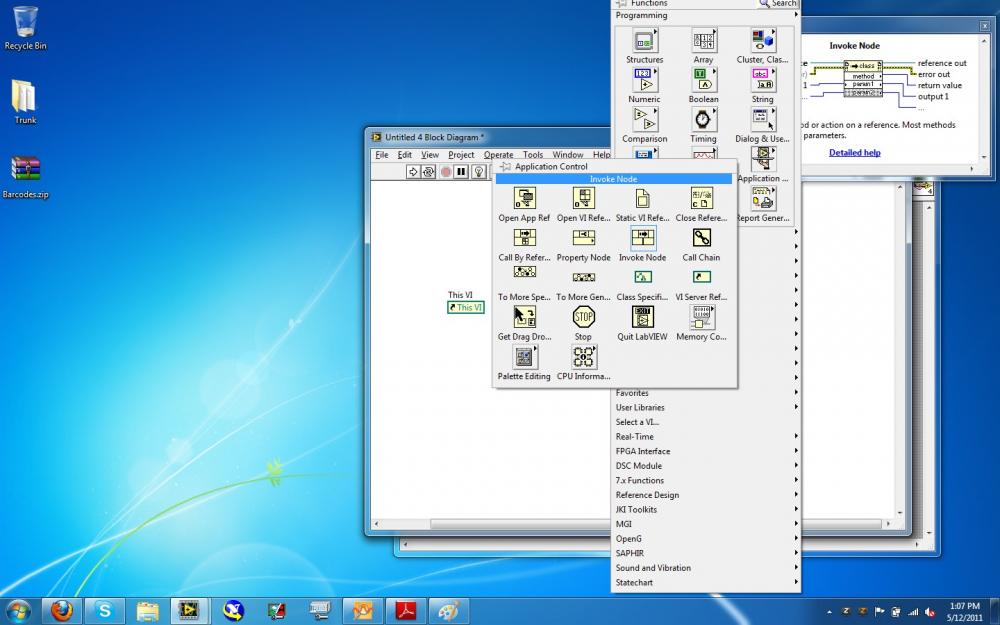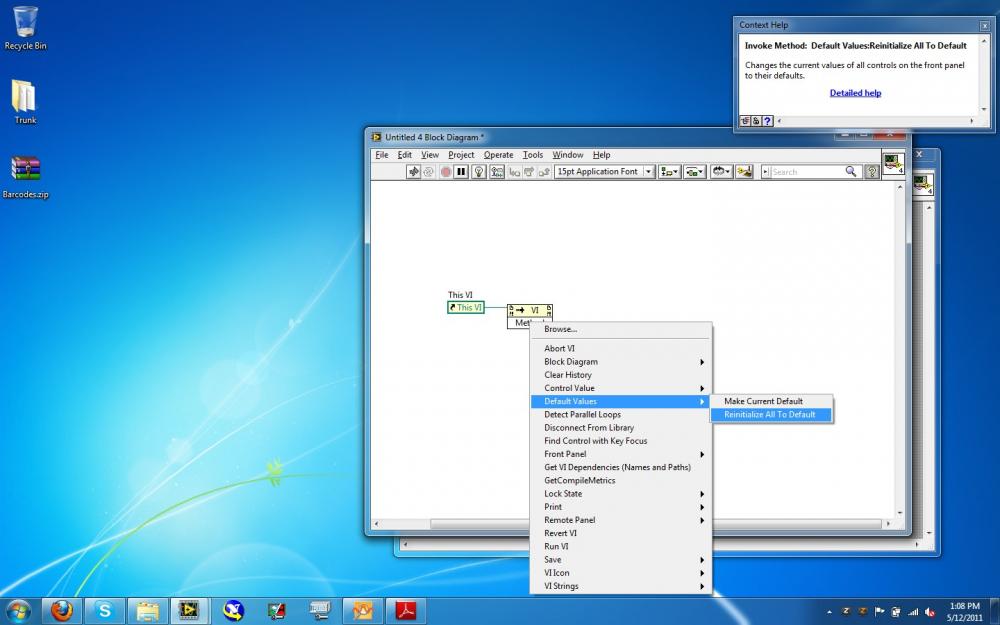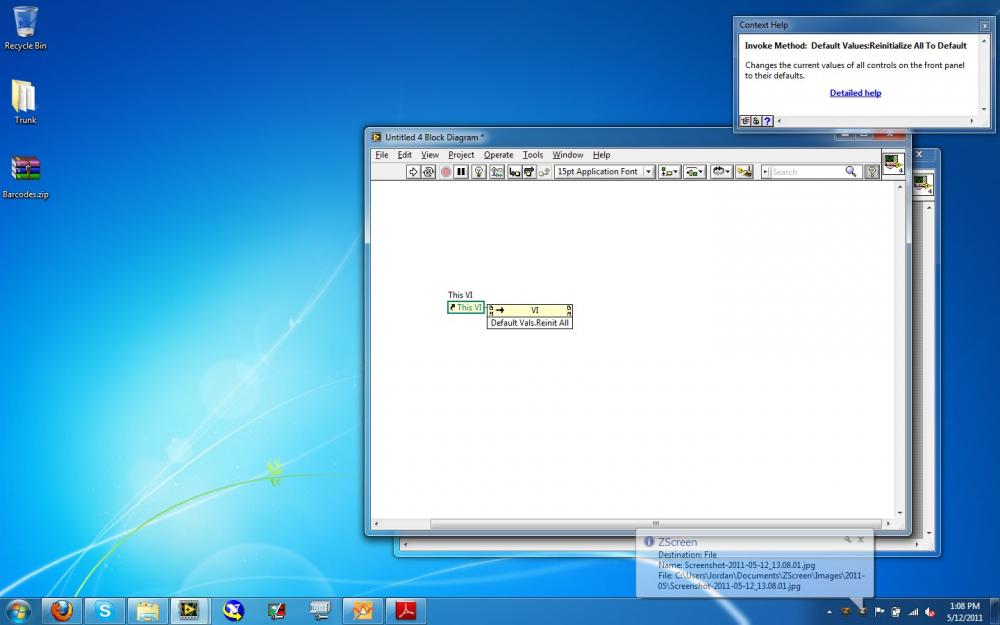-
Posts
693 -
Joined
-
Last visited
-
Days Won
21
Content Type
Profiles
Forums
Downloads
Gallery
Posts posted by Jordan Kuehn
-
-
essentially I found the GET and POST commands sent by the web interface and then mimicked them in LabVIEW. You'll need to get familiar with the HTTP functions in LabVIEW as well as basic string parsing, type conversion, loops, and conditional structures.
-
I would start with a packet sniffer. You will probably have to develop/replicate the http interface. I've used Wireshark before to see what commands were used to interface with an unsupported IP camera.
-
 1
1
-
-
Also, just to be on the safe side - a value change event is also triggered if you call the Value (signaling) property on the control, which is relatively easy to check by looking for all of the control's references or property nodes. This doesn't cover everything (e.g. someone using the pane's Controls[] property, but it covers most of it. Also, this can't be done for latched booleans, so if it's latched, you can also know it's not that.
There is no use of the value (signaling) property in the VI, and no access to the Controls[] is being done. It's a fairly simple subVI.
My guess is that another event case was executing (and showing it's SubVIs FP). During this, a click was performed on the suspected button (has to be enabled) on the Main VI. When the SubVI was closed and the event was finished, the queued up event was proceeded. Propably a more complex variation of this, which did also do the disabeling&greying out.
Felix
Perhaps my description wasn't clear enough. The two buttons in question reside on the front panel of the subVI which behaves like a dialog prompt. There are two event structures, on in the main vi and one in the sub vi; however, the action in question was the action triggered by that button value change in the subvi.
-
After looking at it several times, we may just have to go with the obvious option. It behaved as expected and the operator didn't want to admit it.
-
Hey guys
I could use some help. Basically I have a vi that entered into a case triggered on a front panel boolean value change. However, this boolean is continually enabled or disabled and grayed out during the timeout case based upon a different controlling boolean. (a quick and dirty admin mode if you will).
The operator claims that the button was grayed out the entire time and that the state was entered into without any action on his part after the subVI began to run.
Any thoughts? I'm having trouble explaining why it got there.
-
A custom windows environment variable could do the trick. Attached is code that I have used a couple times to see which machine it's on.

Keep in mind, LabVIEW will not see a new variable without being restarted.
//Edit
Not good if you're only interested in IP address obviously.
-
Bitbucket looks great except for one thing.
I can handle moving to mercurial, and I can even handle splitting my SVN repo into multiple by-project repos and simply organizing the repos into folders by customer. However, it looks like on bitbucket I have to place all of the repos at the same folder heirarchy level. That would force me to do something like [Customer_ProjectName] instead of [Customer]/[ProjectName]. Is there a way around this? I have too many projects to leave them all in a single folder.
-
I'd also be interested in a good project hosting service that allows for private project and svn integration. post-commit hooks would be nice as well.
-
Does sourceforge allow for private projects?
-
I have complained before about Error 6 but am still of the opinion that it is better than having files outside of the build.
I would be nice if NI could do the build in a temp directory (as close to the root as possible) to avoid this, then copy it back to the dist location - all transparently (I currently have to use a script to do this manually).
Care to submit to the Idea Exchange? I would love this feature. Often times when giving RT code to a coworker for testing builds fail because his folder structure is much deeper than mine. Building and deploying on the desktop before moving into the final destination is a complete PTA.
-
Couldn't you kill the process via the command line?
This VI from the dark side shows some of the commands.
-
awesome!
-
I second crelf's questions and suggestions.
I would also like to be able to turn on and off a power source, but am not sure this is possible as I haven't been able to find any really helpful text.
Without knowing what kind of power source you are trying to switch, what load you are driving, and how fast you want to switch it, you can achieve this with a suitable relay and a single digital output line.
If you have an ni motor controller for the stepper motor you mentioned you can likely find and example for it in the example finder in LabVIEW (Help->Find Examples...)
-
-
I just got an email from NI that I passed the CLD exam!
I've been poking around here for some time, but not really posting much though I'm sure that will change. There's not too many people in the world that know what a CLD is, so I figured I'd come share it here.
-
 1
1
-
-
I just upgraded from 5 to 2010. I am using a P4 3Ghz PC with XP Pro. The intall (complete Full package) took about 6 hours on this machine. Then again, I installed it on my old laptop but just did the minimum and it was done in about a half hour.
It is very slow to develop code with it now compared to 5 and 6. Selecting save as, for example, took 50 seconds before I got the file menu. The long times are not constant. Sometimes save can return the menu in 10 seconds or so. Pressing undo, I may as well get a coffee.
VI's will run fine, then freeze for a second or so, then run for a while then freeze again. I found if I turned off the NI Webserver that it seemed to solve it. No freezes with a few hours of run time. I have not tried to restart the PC again and see of the problem returns.
The new 3D graphs look very nice compared to the old ones but I was hoping to see a lot more modern looking controls in the library.
I haven't experienced any of these issues you describe. Running LV2010 on both my desktop and laptop. Perhaps something is wrong with your machine.
As far as modern looking controls, I find myself using the system controls a lot. They look nice in windows 7 and decent in XP. There's also a few controls suites in the package manager that are nice.
-
Here's hopefully a simple question:
What is the best method for communicating with an RT target with a Host controller (windows) that may reconnect at any time? Network variables, Remote Panel, Web Services, tcp, udp?
I've used network variables and networks streams plenty, but network variables just don't seem reliable enough and network streams hang when connection is lost. Remote Panel and Web Services seem attractive due to the fact that everything is hosted on the target. I don't need deterministic control on the host interface, just a decent UI.
Thoughts?
-
As suggested earlier, post your code and we can be more helpful. Perhaps even a VI Snippet.
tushar gave you good advice regarding timing when the trigger occurs.
To further elaborate, if you are simply wanting the time from execution to the first threshold, you can place a tick count vi before your while loop. Place another inside the while loop inside a case structure that has the selector wired to the same boolean as what turns the LED on. In the false case you can put the put the tick count from the beginning. Then subtract the two and conditionally wire the result into a numeric indicator. When true you'll see the time between start and threshold, when false you should see 0. I have a feeling you may need a little bit more sophisticated approach, but this should get you started for now.
-
 1
1
-
-
Congratulations Roderic
-
One and only one: Realterm
I second this.
-
This is probably what you are looking for. Once you have an ODBC reference you can call the database by name.
Here's some stuff from NI: http://digital.ni.com/public.nsf/allkb/47A8CF66D5E3C8CC8625720A006139D6
-
Here are my get/set temperature vi's for a Watlow F4 controller. You also need the NI Modbus library.


And there seems to be an issue with the VI snippet. The clusters constants there can be remade and should have RTU and 1 as the values in them.
Hopefully this is of some help to you.
-
 1
1
-
-
I believe you can comment on the review to clarify some of the focus of the book. Here is a generic article that might be a little useful.
-
 1
1
-
-
looks like homework to me







Unexpected entry into event case
in LabVIEW General
Posted
Perhaps, but I think in this case it would be about as unlikely as the user having tabbed several times, hit enter, and did it again. That button hasn't been used for quite some time.
And perhaps the value change event structure could capture double click events in a similar fashion to how windows does it? Then it could be a boolean input into the case.